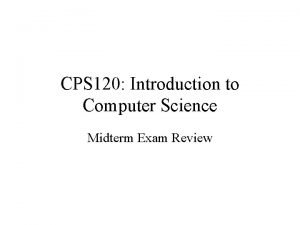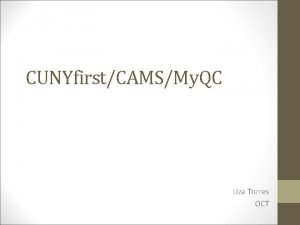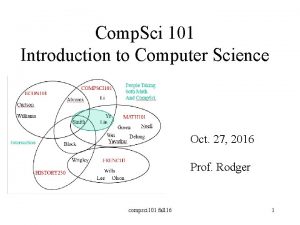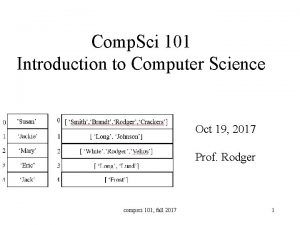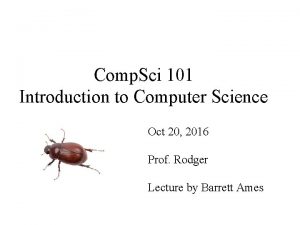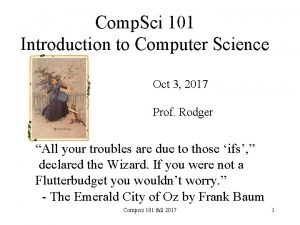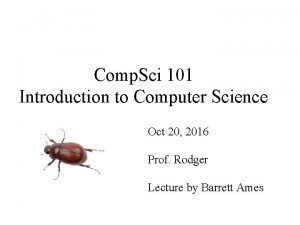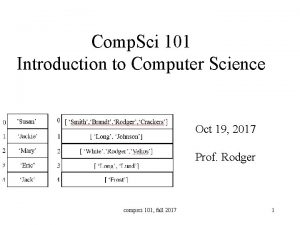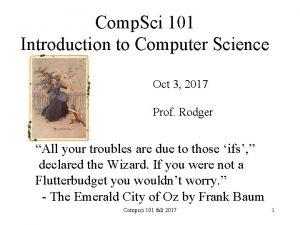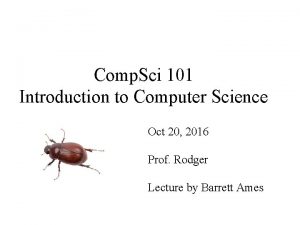Comp Sci 101 Introduction to Computer Science Oct






















![[0, 0] Pixels in an image Background is black, 12 x 9 x [11, [0, 0] Pixels in an image Background is black, 12 x 9 x [11,](https://slidetodoc.com/presentation_image_h/096dab8210640955cdf5cf9fcc2f0c4b/image-23.jpg)





- Slides: 28

Comp. Sci 101 Introduction to Computer Science Oct 31, 2017 Prof. Rodger compsci 101, fall 2017 1

Announcements • • • Next Reading and RQ due Thursday Assignment 6 due Thursday APT 5 due tonight, APT 6 due Nov 7 APT Quiz 2 Sun-Wed next week Lab this week - images • Today: – Nested loops, tuples, images compsci 101, fall 2017 2

ACM Programming Contest Need Volunteers Saturday, Nov 11 at Duke • Over 120 teams, 8 university sites • Team: – 3 people, 1 computer – 8 problems, 5 hours • Need volunteers to deliver printouts, etc – 8: 15 am-12: 30 OR 11: 20 am-6 pm – Get tshirt and meals! compsci 101, fall 2017 3

It’s Halloween • What is Prof. Rodger’s Halloween costume, from long ago….

YARN, in the shape of a binary tree Subtrees made with molecule kit What is it?

2 D-range tree • Search in x-y plane • Main tree organized by x-values • Subtree organized by y values y-range x-range

Binary Search tree of points in the plane – sorted by X-value Each subtree organized by y-value In the x-range Search each subtree by y-value

Problem: Given list of words, find word with most vowels • Example: – Given [‘dog’, ‘cat’, ‘gerbil’, ‘elephant’] – ‘elephant’ has 3 vowels, the most • To solve – nested loops: – Loop over words in list • For each word: Loop over characters in word compsci 101, fall 2017 8

Bit. ly/101 f 17 -1031 -1 • a compsci 101, fall 2017 9

Problem – Given two lists of names, print a list of pairs of names in which the two names are the same length • A = [‘mo’, ’ted’, ’bill’] • B = [‘billie’, ‘jes’, ‘bo’] • To solve – for name in A: for name in B: Check length print pair compsci 101, fall 2017 mo, bo ted, jes 10

Bit. ly/101 f 17 -1031 -2 • a compsci 101, fall 2017 11

APT - Unique. Zoo • How do you solve this problem? • How is it similar to the problem we just solved compsci 101, fall 2017 12

Example Data for Unique. Zoo ["zebra bear fox elephant", "bear crocodile fox", "rhino elephant crocodile kangaroo", "elephant bear"] fox zebra bear crocodile elephant rhino kangaroo compsci 101, fall 2017 13

Unique. Zoo – two zoos have unique animals fox zebra bear crocodile elephant rhino kangaroo 14 compsci 101, fall 2017

Image Processing • What's real, what's Photoshopped – http: //bit. ly/1 Kj 0 Kn 6 from 2008 – Learn more at http: //bit. ly/1 Psi 0 h. G, we'll do very basic stuff in class and lab, next assignment too! compsci 101, fall 2017 15

Example: convert color to gray scale Process each pixel Convert to gray compsci 101, fall 2017 16

Example: convert blue to green Process each pixel Convert blue ones to green Is this like red-eye removal? compsci 101, fall 2017 17

Lab 8 • You’ll create new images – Invert – Solarize – Darken – Brighten – etc compsci 101, fall 2017 18

Need new concepts and Image library • Red, Green, Blue color model – Triples of (R, G, B) are processed as Python tuples. – Let's study tuples! • Images can be very big, what's 4 K display? – 4, 096 x 2, 160 = 8, 847, 360 pixels, 8 Mb at least – Creating huge lists takes up memory – Sometimes only need one pixel at-a-time – Let's study generators! compsci 101, fall 2017 19

Need new concepts and Image library • Red, Green, Blue color model – Additive model, each pixel specified by (r, g, b) triple, values of each between 0 -255 – https: //en. wikipedia. org/wiki/RGB_color_model – White is (255, 255) and Black is (0, 0, 0) • Images stored as sequence of (r, g, b) tuples, typically with more data/information too – 256 values, represented as 8 bits, 28 = 256 – 32 bits per pixel (with alpha channel) – In Python we can largely ignore these details! compsci 101, fall 2017 20

Image library: Two ways to get pixels • Each pixel is a tuple in both models – Like a list, indexable, but immutable – pix = (255, 0, 0) • What is pix? , pix[0]? What is pix[5]? • Invert a pixel: by subscript or named tuple – Access by assignment to variables! npx = (255 -pix[0], 255 -pix[1], 255 -pix[2]) (r, g, b) = pix npx = (255 -r, 255 -g, 255 -b) compsci 101, fall 2017 21

Let's look at Gray. Scale. py • Key features we see – Import Image library, use API by example – Image. open creates an image object • Image functions for Image object im – im. show(), displays image on screen – im. save("xy"), saves with filename – im. copy(), returns image that's a copy – im. load(), [x, y] indexable pixel collection – im. getdata(), iterable pixel collection • Let's look at two ways to process pixels! 22
![0 0 Pixels in an image Background is black 12 x 9 x 11 [0, 0] Pixels in an image Background is black, 12 x 9 x [11,](https://slidetodoc.com/presentation_image_h/096dab8210640955cdf5cf9fcc2f0c4b/image-23.jpg)
[0, 0] Pixels in an image Background is black, 12 x 9 x [11, 0] y [8, 4] compsci 101, fall 2017 23

Image Library: open, modify, save • Image. open can open most image files –. png, . jpg, . gif, and more – Returns an image object, so store in variable of type Image instance – Get pixels with im. getdata()or im. load() • Image. new can create a new image, specify color model "RGB" and size of image – Add pixels with im. putdata() compsci 101, fall 2017 • These belong to Image package 24

im. getdata(), accessing pixels • Returns something like a list – Use: for pix in im. getdata(): – Generates pixels on-the-fly, can't slice or index unless you use list(im. getdata()) – Structure is called a Python generator! – Saves on storing all pixels in memory if only accessed one-at-a-time • See usage in Gray. Scale. py, note how used in list comprehension, like a list! compsci 101, fall 2017 25

Questions bit. ly/101 f 17 -1031 -3 compsci 101, fall 2017 26

Alternate : Still Tuples and Pixels • The im. getdata() function returns listlike iterable – Can use in list comprehension, see code – Use. putdata() to store again in image pixels = [make. Gray(pix) for pix in im. getdata()] def make. Gray(pixel): r, g, b = pixel gray = (r+g+b)/3 return (gray, gray) compsci 101, fall 2017 27

Making Tuples and Generators • Overuse and abuse of parentheses – To create a tuple, use parentheses for pix in im. getdata(): (r, g, b) = pix npx = (255 -r, 255 -g, 255 -b) – To create a generator use parentheses as though creating a list comprehension! [2*n for n in range(10000)] (2*n for n in range(10000)) • See this in Py. Dev console compsci 101, fall 2017 28
 Recursion ap csa
Recursion ap csa Eecs 110
Eecs 110 Comp sci 1102
Comp sci 1102 Comp sci 1027
Comp sci 1027 Comp sci 301 uw madison
Comp sci 301 uw madison Comp 101 unc
Comp 101 unc My favourite subject is music
My favourite subject is music Think central k5
Think central k5 Introduction to computer science midterm exam
Introduction to computer science midterm exam Introduction to computer science midterm exam test
Introduction to computer science midterm exam test C++ code
C++ code Python programming an introduction to computer science
Python programming an introduction to computer science Bi tri quad
Bi tri quad Mahatma gandhi life history
Mahatma gandhi life history Systemy liczbowe
Systemy liczbowe Oct 3 1993
Oct 3 1993 Low na
Low na La formule brute des alcanes
La formule brute des alcanes Oct 31st sunset
Oct 31st sunset Oct spectralis
Oct spectralis Visante oct
Visante oct Whats emplid
Whats emplid Eteno
Eteno Ims design software
Ims design software Meth eth prop but order
Meth eth prop but order What is chemistry
What is chemistry Oct vizsgálat ára
Oct vizsgálat ára Meth eth prop but pent hex
Meth eth prop but pent hex Jhlt. 2019 oct; 38(10): 1015-1066
Jhlt. 2019 oct; 38(10): 1015-1066








